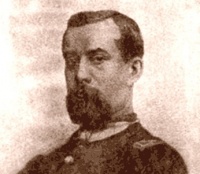George H. Felt: Difference between revisions
Pablo Sender (talk | contribs) |
|||
| Line 6: | Line 6: | ||
== Theosophical involvement == | == Theosophical involvement == | ||
Mr. Felt claimed to have discovered how Egyptian priests invoked and commanded the [[Elemental|spirits of the elements]]. He declared he was able to demonstrate this and render them visible. On [[September 7]], 1875, he gave a lecture at [[Helena Petrovna Blavatsky|Mme. Blavatsky]]'s rooms on the subject "The Lost Canon of Proportion of the Egyptians, Greeks and Romans." About 17 people were present. During the discussion that followed a suggestion was made that a Society be formed to pursue and promote such occult research. | Mr. Felt claimed to have discovered how Egyptian priests invoked and commanded the [[Elemental|spirits of the elements]]. He declared he was able to demonstrate this and render them visible. On [[September 7]], 1875, he gave a lecture at [[Helena Petrovna Blavatsky|Mme. Blavatsky]]'s rooms on the subject "The Lost Canon of Proportion of the Egyptians, Greeks and Romans." About 17 people were present. During the discussion that followed a suggestion was made that a Society be formed to pursue and promote such occult research. | ||
The next day there was another meeting at H.P.B.'s place, [[The Lamasery]], in which Mr. Felt lectured again. During this meeting the idea of a Society was more definitely developed, [[Founders|sixteen people]] handing in their names for that purpose. A committee of three was appointed to draft a Constitution and Bylaws. | The next day there was another meeting at H.P.B.'s place, [[The Lamasery]], in which Mr. Felt lectured again. During this meeting the idea of a Society was more definitely developed, [[Founders|sixteen people]] handing in their names for that purpose. A committee of three was appointed to draft a Constitution and Bylaws. | ||
Revision as of 16:16, 27 January 2018

George Henry Felt was a mechanical engineer, architect, and Egyptologist, and one of the Founders of the Theosophical Society.
Born on September 21, 1831 in Boston, Massachusetts, he married Mary Anne Frain in New York, on September 23, 1854. During his participation in the Civil War he invented a flare for military communication operations and a detonator.[1] He died on December 9, 1906, though some sources say 1895.
Theosophical involvement
Mr. Felt claimed to have discovered how Egyptian priests invoked and commanded the spirits of the elements. He declared he was able to demonstrate this and render them visible. On September 7, 1875, he gave a lecture at Mme. Blavatsky's rooms on the subject "The Lost Canon of Proportion of the Egyptians, Greeks and Romans." About 17 people were present. During the discussion that followed a suggestion was made that a Society be formed to pursue and promote such occult research.
The next day there was another meeting at H.P.B.'s place, The Lamasery, in which Mr. Felt lectured again. During this meeting the idea of a Society was more definitely developed, sixteen people handing in their names for that purpose. A committee of three was appointed to draft a Constitution and Bylaws.
A third lecture was given by him on September 13 at the same place, and during this meeting the name of the Theosophical Society was agreed upon.
Mr. Felt was elected as Vice-President of the Society, but failed to keep his promise. In Col. Olcott's words, "he never showed us so much as the wag of the tail of a vanishing elemental".[2]
According to historian Josephine Ransom, "Felt drifted out of The Society. He was in England in 1877 and proposed the formation of a Society for occult research, with himself as President. Nothing came of this proposal".[3]
Online resources
Articles
- George Henry Felt at Signal Corps Association website
- The First Leaf of T.S. History by Henry S. Olcott
- Search for George H. Felt’s lost work at Chasing Down Emma blog
Notes
- ↑ George Henry Felt at Signal Corps Association website
- ↑ The First Leaf of T.S. History by Henry S. Olcott
- ↑ Josephine Ransom, A Short History of The Theosophical Society (Adyar, Madras, India: The Theosophical Publishing House, 1938), 111.